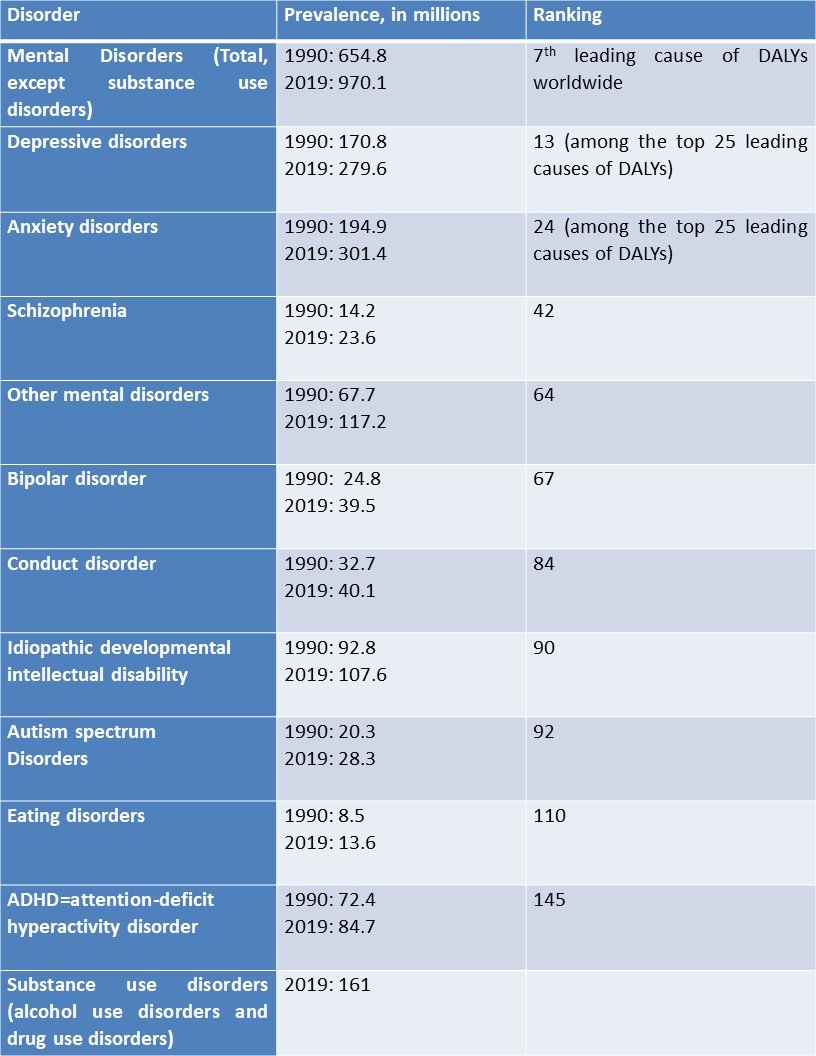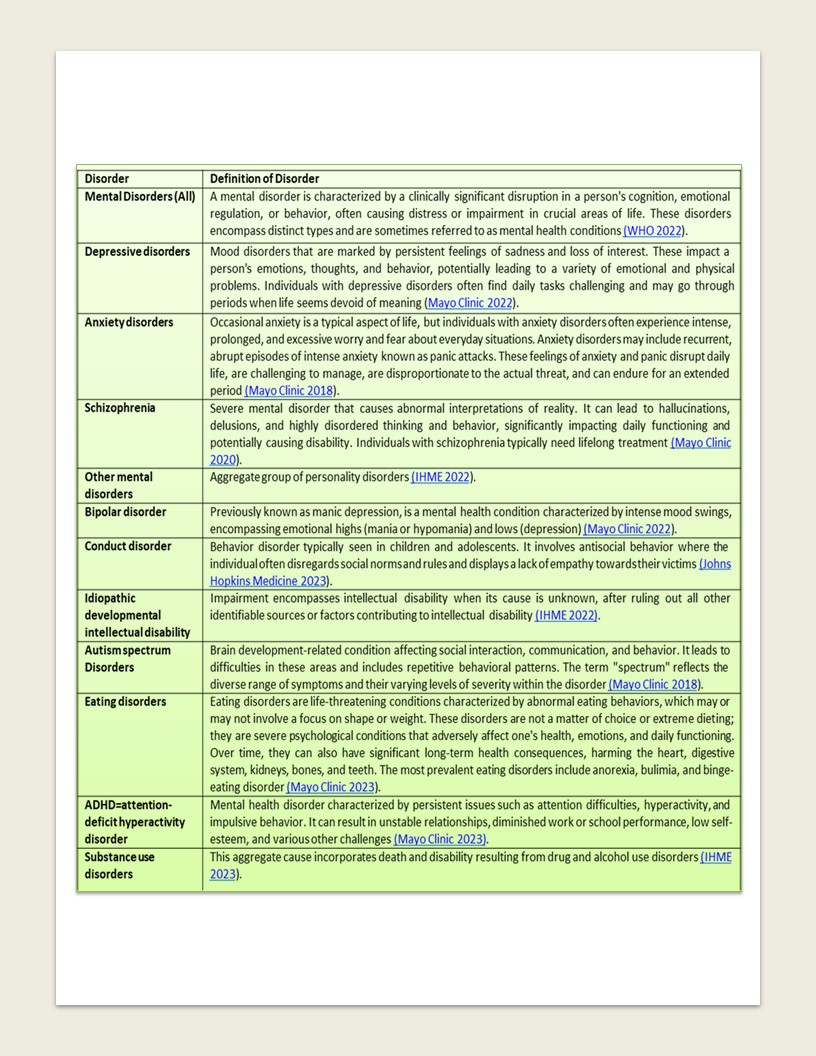Exploring the Intersection of Mental Health and Well-Being with Disability in the Workplace

Patricio V. Marquez and Catherine Waithira Mwaniki
“We can build workplaces that are engines of well-being, showing workers that they matter, that their work matters, and that they have the workplace resources and support necessary to flourish.”
The U.S. Surgeon General’s Framework for Workplace Mental Health & Well-Being (2022)
The 2023 International Day of Persons with Disabilities underscores the importance of acknowledging, respecting, and supporting individuals who face challenges impacting their daily lives. As members of the World Bank Group Mental Health Strategy Implementation Secretariat, we delve into the intersection of mental ill-health, disability, inclusion, and well-being. We consider that this exploration is key to promoting a more empathetic and inclusive workplace, ensuring that individuals experiencing mental health conditions receive the support they need and are empowered to thrive in every aspect of their lives.
Distinction Between Mental Health and Mental Illness
Mental and physical health are equally important components of overall health and well-being. As defined by the World Health Organization (WHO), mental health is a state of well-being that enables individuals to cope with life's stresses, realize their potential, and contribute to their community. Mental health is not static, varying along a continuum, with individuals facing distinct levels of challenges and distress. Factors at the individual, family, community, and structural levels can either safeguard or impair mental health, thereby affecting where an individual stands on this health continuum at any given time.
Good mental health denotes a state of emotional and psychological stability, enabling individuals to function well in daily life, sustain relationships, and tackle life's challenges. In contrast, as presented in Table 1, mental illnesses or disorders encompass a spectrum of conditions that are diagnosed and treated based on symptoms reported by individuals and manifestations observed and measured by others. Individuals experiencing mental health conditions may display a range of symptoms that vary in severity, from mild ones that are not easily noticeable or ‘invisible’, to more pronounced manifestations like confusion, agitation, or withdrawal.
Despite the variation in symptoms among different mental health conditions, certain common warning signs exist that suggest the need for psychosocial support or medical intervention. These include noticeable personality shifts, difficulty coping with daily challenges, unconventional or exaggerated beliefs, high levels of anxiety, severe depression, major alterations in eating or sleeping patterns, thoughts of self-harm or suicide, intense mood fluctuations, substance use disorders, and excessive anger or violent behavior.
Neurodivergent traits, while unique and valuable, can pose challenges in social settings with established norms, potentially leading to difficulties and co-occurring mental illnesses such as depression and anxiety, particularly prevalent in individuals with autism, dyspraxia (difficulties in planning and completing fine and gross motor tasks), and attention-deficit hyperactivity disorder (ADHD).
Table 1: Mental Disorders Categories
Source: Elaborated by authors with information from different sources listed next to each condition category, respectively, as follows: WHO 2022; Mayo Clinic 2022; Mayo Clinic 2018; Mayo Clinic 2020; IHME 2022; Mayo Clinic 2022; Johns Hopkins Medicine 2023; IHME 2022; Mayo Clinic 2018; Mayo Clinic 2023; Mayo Clinic 2023; IHME 2023
When Does a Mental Health Condition Become a Disability?
Disabilities manifest as conditions that hinder or impede an individual's ability to perform specific activities and interact with their environment. They include impairment (abnormalities in body structure, function, or mental capabilities, such as limb loss or memory impairment), activity limitation (difficulties in performing tasks, affecting vision, hearing, mobility, or problem-solving), and participation restrictions (barriers to engagement in everyday activities like work, social interaction, and accessing healthcare). Many disabilities are not outwardly visible, and this includes mental health conditions, which are often “invisible” or not immediately apparent to others.
A mental health condition is considered a disability when persistent symptoms cause significant distress and their manifestations have a long-term effect on normal day-to-day activity and social engagement (e.g., working and interacting with family members and other people). However, with effective management through treatment, support, and coping strategies, many people with mental health conditions lead fulfilling lives. Therefore, it is important to understand that mental illness does not signify personal weaknesses or character flaws but represents conditions akin to physical illnesses, like cancer or heart disease.
Mental Disorders Are Leading Causes of Disability Worldwide
Recent epidemiological and economic estimates provide evidence of the significant global burden of mental health conditions, impacting both human health and societal welfare. As presented in Table 2, the estimates of the 2019 Global Burden of Disease (GBD) study show that mental disorders accounted for 654.8 million cases in 1990 and 970·1 million cases in 2019, corresponding to an increase of 48·1 percent between 1990 and 2019.
Using the Disability-Adjusted Life Year (DALY) metric, which assesses the burden of a disease by calculating the sum of the years of life lost due to premature mortality (YLLs) from that cause and the years of years of healthy life lost due to disability (YLDs) for people living in states of less than good health resulting from the specific cause, mental disorders were responsible for 125.3 million DALYs in 2019. This translates to an age-standardized DALY rate of 1566.2 per 100,000 people, accounting for 4.9 percent of total DALYs. Substance use disorders were responsible for 35.1 million DALYs in 2019, representing 1.4 percent of total DALYs. Alcohol use disorders caused 48.4 percent and drug use disorders 51.6 percent of DALYs due to substance use disorders.
Globally, mental disorders were the seventh leading cause of DALYs in 2019. At the disorder level, depressive disorders and anxiety disorders were ranked 13th and 24th among the top 25 leading causes of DALYs in 2019. Mental disorders were the second leading cause of YLDs worldwide in both 1990 and 2019. It is important to highlight that the estimated DALYs for mental disorders and substance use disorders primarily consist of YLDs, rather than deaths.
Table 2. Mental Disorders and Substance Use Disorders: Global Prevalence and Rankings of Disability-Adjusted Life Years (DALYs) by all Ages for both Sexes Combined, 1990 and 2019.

Source: Elaborated by the authors using IHME estimates presented at “Global, regional, and national burden of 12 mental disorders in 204 countries and territories, 1990–2019: a systematic analysis for the Global Burden of Disease Study 2019”: https://www.thelancet.com/journals/lanpsy/article/PIIS2215-0366(21)00395-3/fulltext, updated “Substance use disorders—Level 2 cause: https://www.healthdata.org/results/gbd_summaries/2019/substance-use-disorders-level-2-cause
A recent study, incorporating updated estimates and methodologies for quantifying the global burden of mental illness, suggests that the burden of mental illness in terms of both health and economic losses may be much higher than previously assessed. It showed that in 2019, approximately 418 million DALYs were linked to mental disorders, comprising 16 percent of global DALYs--a more than three-fold increase compared to previous estimates. The economic impact of mental disorders losses was estimated in this study to be approximately US$4.7 trillion when calculated using Gross Domestic Product (GDP) per capita as a proxy for the value per DALY. It is important to note, as cautioned by the authors of the study, that these economic losses do not represent an actual loss to GDP, but rather these estimates are used to illustrate the scale of the economic consequences with respect to GDP.
The COVID-19 pandemic also created an environment that exacerbated poor mental health outcomes and associated disability. Indeed, a 2021 global study published in The Lancet reported a significant increase in the prevalence of both major depressive and anxiety disorders among all genders. Mental disorders have been shown to be a major risk for developing alcohol and drug dependency, which in turn, further aggravate the disability effects of these disorders.
Mental Disorders Are a Recognized Disability in the Workplace
The disability burden of mental disorders in the workplace is significant. For example, depression and anxiety disorders are estimated to result in the loss of 12 billion working days annually worldwide, costing approximately US$1 trillion in lost productivity. Also, as reported by the OECD, mental illness is a particularly frequent diagnosed cause for disability benefit claims among young adults, who in many countries increasingly enter the disability benefit system without any significant time spent in the workforce and stay on benefits for their lifetime.
Effective measures exist to prevent mental health risks, promote workplace mental health, and support employees dealing with mental health conditions. Disability laws and acts have been adopted in different countries to prevent discrimination against persons with disabilities, including those conditions associated with mental disorders, and eliminate barriers towards the full enjoyment of their rights and their inclusion in society. For example, under the Americans with Disabilities Act (ADA) in the United States, a mental health condition qualifies as a disability if it significantly limits one or more major life activities. This designation provides protection against workplace discrimination and harassment based on one's mental health condition, guarantees privacy rights, and allows for reasonable accommodations to facilitate job performance and retention. Workplace accommodations vary from person to person, but could include flexible work hours, modified job tasks, or time off for mental health disorder-related leave--all of which are intended to assist individuals in performing their jobs effectively while prioritizing their well-being.
Takeaways
Although the WHO declared in May 2023 the end of COVID-19 as a public health emergency, the pandemic has left a profound mental health crisis in its wake. The stress and anxiety that the pandemic brought, which have been aggravated by economic uncertainty, global turmoil, and technological change, continue to affect people across the world. More ominous, as explained by Prof. Adam Tooze of Columbia University, in an interview published by the World Economic Forum (WEF), “This is a huge shock that is going to reverberate through global society…there are… globally hundreds of millions of young people who've been deprived of years of education, socialization and everything that goes with that…”
The important role that workplaces can play as “engines of mental health and well-being” in the post-pandemic era cannot be overstated. There is a growing recognition and appreciation now for the relationship between the work environment, culture, community, and health conditions. For example, the results of the 2023 Work in America Survey highlight the significant emphasis workers place on psychological well-being and respect in their workplace. A striking 92 percent of respondents expressed that it is either very (57 percent) or somewhat (35 percent) important for them to be employed by an organization that values their emotional and psychological well-being, while a similar percentage (92 percent) noted the importance of working for a company that supports employee mental health.
The 2023 International Day of Persons with Disabilities provides an opportunity for both public and private organizations to acknowledge the disability impact of mental illness on workers and management alike and to reinforce their commitment to support people experiencing physical and mental disabilities, as a key investment in staff wellbeing, organizational performance, and competitiveness. Indeed, as clearly articulated by a Workplace Wellness Leader in the Technology Sector, this is critical importance since “The leaders of a company set the tone, and if they’re willing to talk about mental health, that trickles all the way down.”
Efforts to raise awareness and reduce stigma and discrimination are essential in fostering understanding and support for individuals dealing with mental health conditions and associated disabilities in the workplace. Besides facilitating access to health and other support services, implementing reasonable accommodation arrangements is necessary to deal with disabilities caused by mental disorders and promote inclusion in the workplace.
In the aftermath of the pandemic, the crucial factor in facilitating the transition back to in-person work, retaining staff, and enhancing mental health and well-being is the adoption of organizational changes that promote work-life harmony, effectively balancing work and personal demands. Drawing from the experiences of various organizations, achieving this can be accomplished by bolstering worker autonomy, granting employees more control over their tasks, and providing increased workplace flexibility regarding when and where work is conducted.
Going forward, it should be clear to all that employees are not just essential assets to any organization and that their health and happiness play a crucial role in enhancing their performance and overall contribution to the organization. Actively promoting employee mental health and well-being, therefore, is critical for the immediate and long-term success of organizations. Indeed, as highlighted in a recent OECD report, “good mental health is a vital part of people’s well-being and essential for individuals and societies to thrive”.
Source of Image: Title: “Souls that Flew in the Sky”, painting by Yayoi Kusama (2016). Photo taken by one of the authors at the Guggenheim Museum, Bilbao, October 4, 2023.

